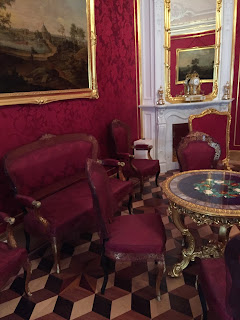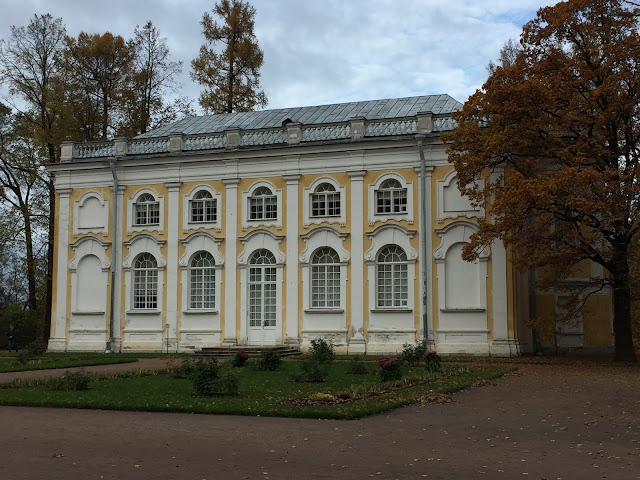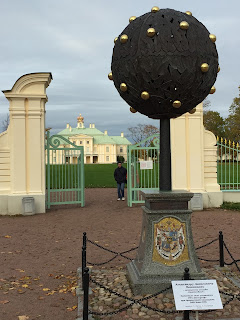146. St. Petersburg's suburban palaces #6 - Oranienbaum
Lomonosov (known as Oranienbaum prior to 1948) is a town on the south shore of the Gulf of Finland, at the extreme western edge of St. Petersburg's city limits. It is directly south of (and a brief drive from) Kotlin Island in the middle of the Gulf. Lomonosov is the location of one of St. Petersburg's imperial estates. The Grand Menshikov Palace is the focal point of the estate, with formal gardens to the north, open parks spreading to the south and west, and a variety of follies and outbuildings dotting the landscape.
The Grand Menshikov Palace at Lomonosov (more generally referred to itself as Oranienbaum) was constructed between 1711 and 1727 for Alexander Menshikov. Menshihkov was one of Peter the Great's closest friends and was one of the most powerful men in Russia (too powerful, in the opinion of the rest of the nobility, who stripped him of his offices a few years after Peter's death and exiled him to Siberia, where he died a few years later). In 1743, the palace became the home of the future Emperor Peter III and his wife, the future Empress Catherine the Great. A series of architects (Rastrelli and Rinaldi chief among them) spent the next three decades expanding the palace, gardens, and building a series of other structures throughout the property.
The palace appears huge from the outside (particularly from inside the courtyard on the south side of the palace), but the wings on either side have not been fully renovated and are not included as part of the normal tour route. The tour focuses on the central building and its dozen or so restored rooms. These were not quite as elaborate as many spaces in the later suburban palaces (some of which were built decades after this one), due to differences in function, architectural trends, and the general philosophy and funding available at the time for construction and furnishing. The walls on the north side of the palace were covered with scaffolding, so reconstruction and renovation efforts are ongoing.
Oranienbaum was the last of the six primary imperial estates and suburban palaces that I needed to visit to complete the full set (there is at least one other palace that I may visit in the future, but these six are the only ones open to individual visitors on a regular daily schedule). It's just about the farthest from the city center, approximately 10-15 minutes further west from Peterhof. Only Gatchina takes longer to reach from the city center. The palace at Oranienbaum is the oldest of the six, and the only one that survived the Great Patriotic War completely intact; the Nazis never occupied this area, even though they had the town more or less completely surrounded for several years. This has allowed the original structure and decorations a degree of preservation absent at the other palaces, but also made this the lowest priority in the twenty-first century for allocating funds for restoration or conservation.
It does not seem like English-speaking tourists often visit Oranienbaum. When I inquired (in what generally seems to be passable Russian) about English-language tours or audio guides in the palace, it turned into a big production involving three staff members, one of whom decided to personally escort me through part of the palace to the room where she wanted me to start the self-guided audio tour. I was surprised that they don't encounter more non-Russian visitors, but it's relatively far down the list of tourist spots and probably doesn't make the cut for any casual visitors to the city. The palace itself was beautiful, although clearly not a blockbuster destination like Peterhof or Tsarkoye Selo.
One of my colleagues recommended Lomonosov as her favorite suburban estate, primarily because of the park rather than the palace. Unfortunately, 30-40% of the park is currently fenced off due to ongoing restoration work, so I did not have the opportunity to explore the grounds quite as extensively as I might otherwise have preferred. Even so, I would list the park farther down on my personal list, due to its smaller size even if it were fully open.
The park did include a few spectacular follies. Foremost among them is the Sliding Hill pavilion (designed by Rinaldi). This building was created as the loading platform for a 500-meter-long ride, an early version of a roller-coaster that even Catherine the Great was said to enjoy. I'm not quite sure why such a fancy building was needed for this purpose, but I guess the Russian royalty didn't do anything in a small way in the 18th century. The Sliding Hill pavilion is spectacular from the outside, but not open to visitors (at least on the day I visited); nothing remains of the roller-coaster track. Most of the follies were closed when I was there. I believe this may have been due to them being shut down for the winter (already in October), rather than any current renovation projects. I was able to go inside the Stone Hall, but was unsuccessful in my attempts to visit the Chinese Palace, several kitchen buildings, and the Peterstadt building.
The Grand Menshikov Palace:
The Stone Hall:
The Chinese Palace and its sculpture garden:
Other areas of the park:
Wooded area at the western side of the estate:
Circling back around to the Grand Menshikov Palace:
The Grand Menshikov Palace at Lomonosov (more generally referred to itself as Oranienbaum) was constructed between 1711 and 1727 for Alexander Menshikov. Menshihkov was one of Peter the Great's closest friends and was one of the most powerful men in Russia (too powerful, in the opinion of the rest of the nobility, who stripped him of his offices a few years after Peter's death and exiled him to Siberia, where he died a few years later). In 1743, the palace became the home of the future Emperor Peter III and his wife, the future Empress Catherine the Great. A series of architects (Rastrelli and Rinaldi chief among them) spent the next three decades expanding the palace, gardens, and building a series of other structures throughout the property.
The palace appears huge from the outside (particularly from inside the courtyard on the south side of the palace), but the wings on either side have not been fully renovated and are not included as part of the normal tour route. The tour focuses on the central building and its dozen or so restored rooms. These were not quite as elaborate as many spaces in the later suburban palaces (some of which were built decades after this one), due to differences in function, architectural trends, and the general philosophy and funding available at the time for construction and furnishing. The walls on the north side of the palace were covered with scaffolding, so reconstruction and renovation efforts are ongoing.
Oranienbaum was the last of the six primary imperial estates and suburban palaces that I needed to visit to complete the full set (there is at least one other palace that I may visit in the future, but these six are the only ones open to individual visitors on a regular daily schedule). It's just about the farthest from the city center, approximately 10-15 minutes further west from Peterhof. Only Gatchina takes longer to reach from the city center. The palace at Oranienbaum is the oldest of the six, and the only one that survived the Great Patriotic War completely intact; the Nazis never occupied this area, even though they had the town more or less completely surrounded for several years. This has allowed the original structure and decorations a degree of preservation absent at the other palaces, but also made this the lowest priority in the twenty-first century for allocating funds for restoration or conservation.
It does not seem like English-speaking tourists often visit Oranienbaum. When I inquired (in what generally seems to be passable Russian) about English-language tours or audio guides in the palace, it turned into a big production involving three staff members, one of whom decided to personally escort me through part of the palace to the room where she wanted me to start the self-guided audio tour. I was surprised that they don't encounter more non-Russian visitors, but it's relatively far down the list of tourist spots and probably doesn't make the cut for any casual visitors to the city. The palace itself was beautiful, although clearly not a blockbuster destination like Peterhof or Tsarkoye Selo.
One of my colleagues recommended Lomonosov as her favorite suburban estate, primarily because of the park rather than the palace. Unfortunately, 30-40% of the park is currently fenced off due to ongoing restoration work, so I did not have the opportunity to explore the grounds quite as extensively as I might otherwise have preferred. Even so, I would list the park farther down on my personal list, due to its smaller size even if it were fully open.
The park did include a few spectacular follies. Foremost among them is the Sliding Hill pavilion (designed by Rinaldi). This building was created as the loading platform for a 500-meter-long ride, an early version of a roller-coaster that even Catherine the Great was said to enjoy. I'm not quite sure why such a fancy building was needed for this purpose, but I guess the Russian royalty didn't do anything in a small way in the 18th century. The Sliding Hill pavilion is spectacular from the outside, but not open to visitors (at least on the day I visited); nothing remains of the roller-coaster track. Most of the follies were closed when I was there. I believe this may have been due to them being shut down for the winter (already in October), rather than any current renovation projects. I was able to go inside the Stone Hall, but was unsuccessful in my attempts to visit the Chinese Palace, several kitchen buildings, and the Peterstadt building.
The Grand Menshikov Palace:
The Stone Hall:
The Sliding Hill Pavilion:
The Chinese Palace and its sculpture garden:
Other areas of the park:
Wooded area at the western side of the estate:
Circling back around to the Grand Menshikov Palace:

























































































































































Comments
Post a Comment